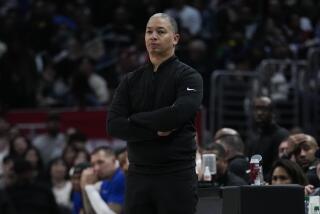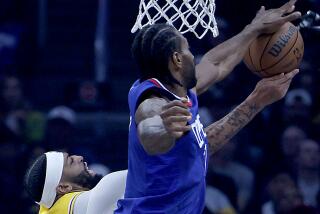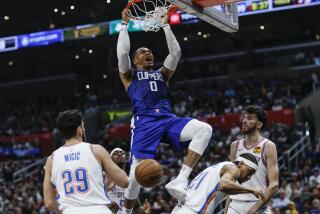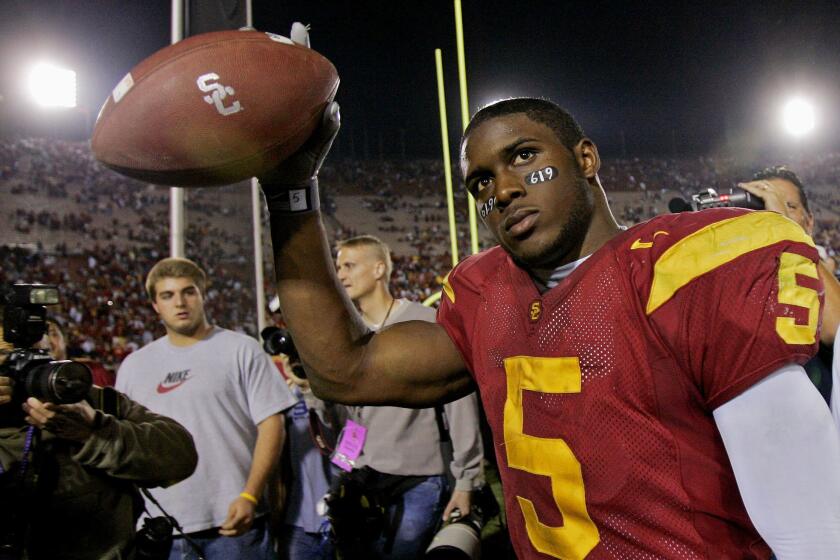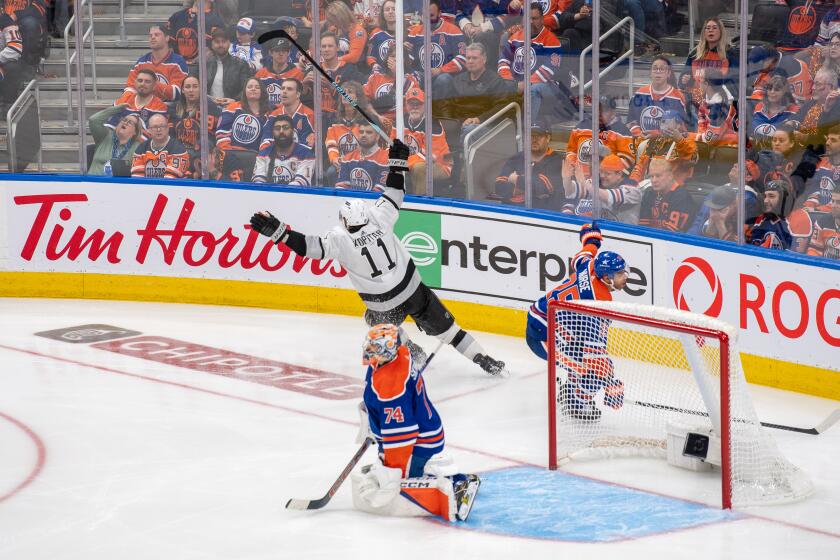Column: Clippers’ blue-collar fans sell tickets to rivals’ fans to stay in black
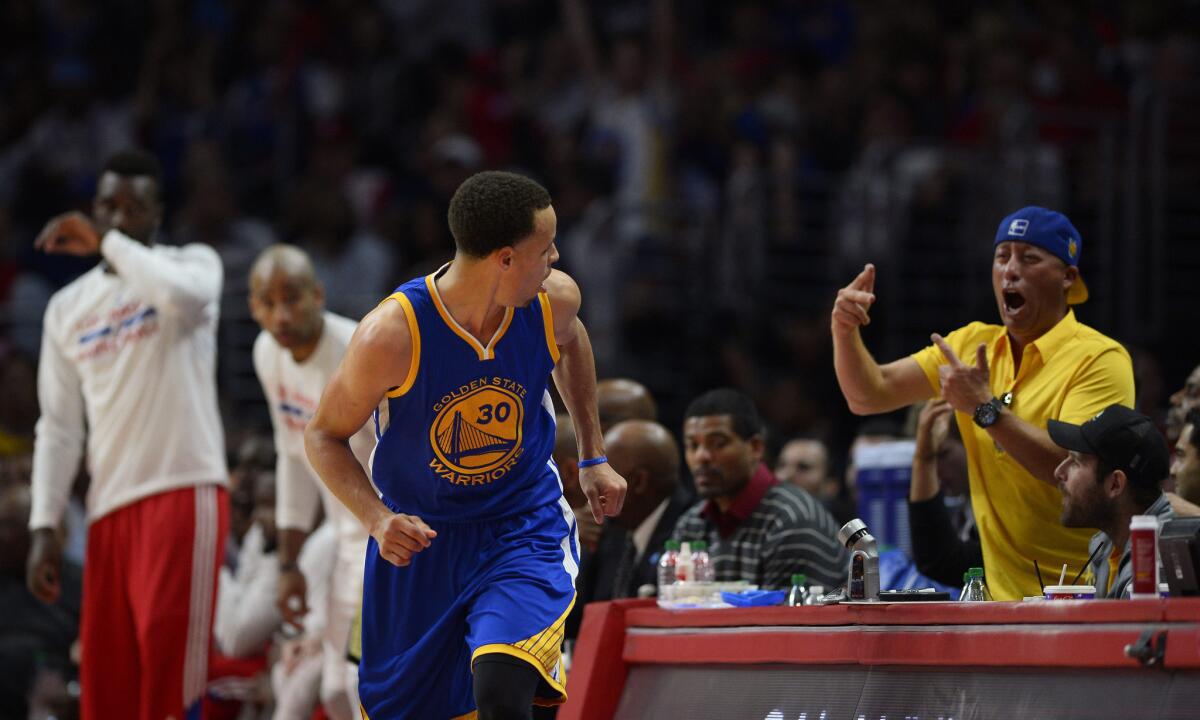
Warriors All-Star guard Stephen Curry had more than this fan courtside cheering for him at Staples Center on Tuesday night during a win over the Clippers.
The words rattled through the city like one of his fan-pleasing dunks.
Only this time, it appeared Blake Griffin was dunking on those fans.
After the Clippers’ demoralizing loss to Golden State in front of a Warriors-centric crowd at Staples Center on Tuesday, Jill Painter of Fox Sports West asked Griffin whether it felt like a playoff game.
“Not really, no,” Griffin said. “Home-court advantage is just not there for us. So if that’s how it feels in the playoffs, then it’s not looking good.”
In talking about the thunderous cheers for Warriors baskets and the “M-V-P” chants for Stephen Curry at the foul line, Griffin was seemingly taking a rare and pointed shot at the long-suffering Clippers faithful.
But he bricked it. His message was right, but his implied target was wrong. The Clippers’ lack of a clear home-court advantage in some big games is the fault not of Clippers fans, but of Clippers team officials, whose consistent and substantial ticket price increases are threatening to turn Lob City into Lame City.
“They have priced me out of going to every game,” said JoLai Draper, a longtime devoted Clippers season-ticket holder.
For 14 seasons, Draper, previously chronicled in this column, has sat in the upper reaches of the lower bowl. Like many Clippers fans, she maintains her season seats through the constant Clippers storms in hopes of one day watching them raise a banner. But because those seats have become so expensive, she now sells individual game tickets to help pay for her season package.
The games that can generate the biggest dollars on the secondary market? Hot brands such as the Cleveland Cavaliers, Chicago Bulls, Miami Heat and, yes, the Golden State Warriors.
Draper admitted two of those yahoos cheering for the Warriors on Tuesday were probably sitting in her seats, because she sold the tickets for $125 apiece, but who can blame her?
Five years ago, at the beginning of the Blake Griffin era, Draper was paying $34 a game for each of her two seats. Next season she will be paying $60 per ticket.
“Their prices have nearly doubled, but during that same time, my salary hasn’t doubled, so I have to figure out a way to make it work,” said Draper, a Boeing procurement agent. “If Blake wants to give me $5,000, I’d be happy to keep my seat and cheer for every game.”
By collecting $250 for her two tickets from a desperate Warriors fan, Draper was able to take a chunk out of next year’s ticket costs. She figures she has banked more than $1,500 this year selling high-demand tickets, and she knows she’s not alone.
“Clipper fans are regular people, and this is a lot of money to a lot of us,” she said. “We don’t want to give up our seats, but we can’t afford to go to every game anymore either.”
Clippers fans are indeed regular people. That has long been a blessing for an organization that has viewed itself as the anti-Lakers. But the way those fans are being slowly priced toward the exits, one wonders whether they aren’t now considered a curse.
It’s as if Steve Ballmer didn’t realize the paradox in paying $2 billion for a team that was always considered Los Angeles’ affordable NBA option. He’s now trying to recoup a Lakers-sized investment in a Clippers-sized culture, and it’s not pretty.
Check out what may be the most amazing statistic in the history of the NBA in Southern California — next season, the best Clippers courtside seats will be more expensive than the price of Lakers courtside seats.
That’s right. That’s not a misprint. The best Clippers courtside seats are $2,840 per ticket, which includes food, parking and admittance to a proposed Clippers-only hospitality room. The Lakers courtside seats are $2,750 per ticket with no food or parking.
Throw out the extras and they are closer to equal, but, seriously? In what universe does that make sense? How can a team with zero championships and just six winning seasons in 31 years in Los Angeles justify being even in the same pricing neighborhood as the most successful pro franchise in this city’s history?
That Clippers courtside figure represents a 39% increase from this season. A couple of rows back, the prices are going up 21%.
Not that any of this is affecting the Clippers ticket sales or home record. They currently have an 180-game sellout streak at Staples Center and, in the last two seasons, the NBA’s third-best home record .
But still, conspiracy theorists wonder whether Ballmer is weeding out his longtime fan base in preparation for moving to an expensive new arena he reportedly hopes to build. Some even wonder whether he’s doing this as a precursor to moving to Seattle, although that theory still makes little sense considering the team would suddenly only be worth only a fraction of its purchase price.
Gillian Zucker, Clippers president of business operations, emailed answers to questions about this changing Clippers spirit.
In regard to rising prices, she wrote, “Most of our fans saw only a 2% to 4% increase in their ticket prices. We are confident that with our low entry-level price point and fair, competitive pricing for a world-class product, we are delivering great value.”
As for fans reselling tickets, she wrote, “We have not discouraged fans from re-selling tickets..we just want to strongly encourage them to resell them to Clippers fans so that we can maintain a competitive advantage for our team.’’
That request, however noble, is a virtually impossible one. If you resell your tickets through the Clippers website — the easiest method of resale — there is no way of knowing who is buying them.
As for the courtside seats being more expensive than Lakers tickets, Zucker wrote, “This is a result of hugely increased demand for premium seats, and a stellar on-court product. There are a host of other new benefits with the ultimate goal of providing the best VIP experience in all of sports.”
But the fans are wondering about that too. There have been complaints that the only thing different about the games this season is the sight of Ballmer doing handstands on the baseline.
The Clippers game presentation is essentially the same, and so is the vibe on the court, where a team with three legitimate stars is nonetheless unable to break free of the middle of the pack in the competitive Western Conference.
Fans are upset with Doc Rivers as a general manager, with the cohesion on the court late in games, and with the idea that the Clippers still don’t look like a team that can advance to its first conference finals.
“We were all overwhelmed with Steve Ballmer coming in, all the hoopla, all the new momentum,” said Robin Salzer, who has had season tickets since the franchise moved to Los Angeles in 1984. “To be honest, I thought they’d be doing better. I really thought this was the year they’d go to the Western finals.”
Salzer’s seats went up from $250 to $300 a ticket for next season, and he said he understands as the product improves, the price soars, but he still wonders.
“The Clippers have always been a blue-collar team, and with that blue-collar persona goes blue-collar prices,” He said. “When that changes, the fan base is inhibited.”
For now, the players have to understand Griffin is right, “It’s not looking good,” for later this month because nothing commands a higher price on the secondary market than a hot playoff ticket.
Draper promises to attend as many playoff games as fiscally possible. But she also knows the reality of what will happen while she’s there.
“It happens all the time, I’ll be looking down at my phone a second, I’ll hear a huge cheer, and I’ll look up thinking we did something good,” she said, sighing. “But it turns out, that cheer is for the other team.”
Twitter: @billplaschke
More to Read
Get our high school sports newsletter
Prep Rally is devoted to the SoCal high school sports experience, bringing you scores, stories and a behind-the-scenes look at what makes prep sports so popular.
You may occasionally receive promotional content from the Los Angeles Times.

